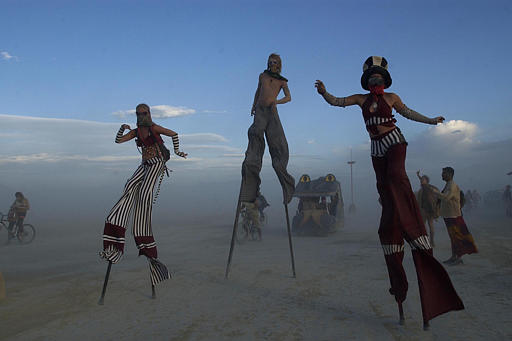Misery, exhilaration mark Burning Man

There are levels of misery associated with Burning Man – wind, dust, heat and the lack of normal services such as electricity and telephones. But this year’s weird weather in the Western U.S. has brought an assortment of unusual challenges. This week, rain has pelted the playa surface, turning it into an unset concrete-like substance that could suck tires into the desert like dinosaurs into the tar pits.
On top of the rain, it was cold out. People come to Burning Man dressed for a warm weather event. There’s a lot of bare skin showing, even on the more modest outfits. So cold rain is an unwelcomed visitor. Shortly after the rain slowed to a barely noticeable drizzle, a double rainbow appeared of such intensity that it looked painted on the sky.
This confluence of meteorological events is the yin and yang of Burning Man. Tough circumstances accompanied by extraordinary happenings. If you’re up for the pain, you’ll be rewarded -- eventually. Most people simply cannot visualize anything beyond the pain and never attend the annual Festival in the Nevada desert. A smaller number venture out once, leave as soon as the first sand storm hits, and never return. But for a few, the Burn is irresistible.
In a society that assaults us with commercial media, Burning Man is an oasis of non-consumerism. Along the Esplanade that fronts the open playa, shows and discos abound. There’s never a cover or minimum at playa bars because the drinks are free. However, the trappings of capitalism remain firmly in place: branding, advertising and measurement of success.
Burning Man rewards success with better placement, so camps that provide very popular services may be situated a bit closer to the center of the action. Those that don’t do as well may end up banished to the outskirts of Black Rock City – blocks behind the Esplanade and Center Camp.
To enhance their potential for success, the camps develop brands, including graphic logos and catch phrases. But the currency of Burning Man is whimsy, so brands that might work in the normal world (called the “default” world by Burners) fall flat for the citizens of Black Rock City. An example is a camp that specializes in new age services that are commonly available at very high prices in most communities. There are yoga sessions, including some advanced level instruction, massage by top level therapists, aroma therapy, reflexology and the like. The camp is called “Heebie Jeebie Healers,” masking its serious purpose with a name that sounds intentionally skeptical.
Some brands play off a real world name to create an “evil twin” approach. The biggest of those this year is an immense installation called Mal-Mart, whose logo is a frowny-face as opposed to Wal-Mart’s smiley face. Branded services even run Public Service Announcements (PSAs) on the Burning Man radio stations and advertise in its daily paper (this year called The Daily Planet in honor of the Festival theme Metropolis).
Burning Man itself is careful to protect its brand and reputation as well. The “man” symbol is a registered trade mark, and Burning Man media relations (at the event it’s known as Media Mecca) insists that all commercial photographers register their gear and clear their photos for publication with the Burning Man organization. All commercial writers and photographers are supposed to give 10 percent of the income from any material developed around the event to the Black Rock Arts Foundation – a non-profit that funds artwork for the Festival.
Despite all of the trappings of modern marketing, Burning Man looks anything but commercial. That’s because most of the camps, bars, cafes and the like are rough-hewn at best, with minimal signage often laced with profanities. Biking down the streets of Black Rock City, you never get the feeling that you’re back home. And that’s the whole point. One week that’s totally unlike the rest of your year.




